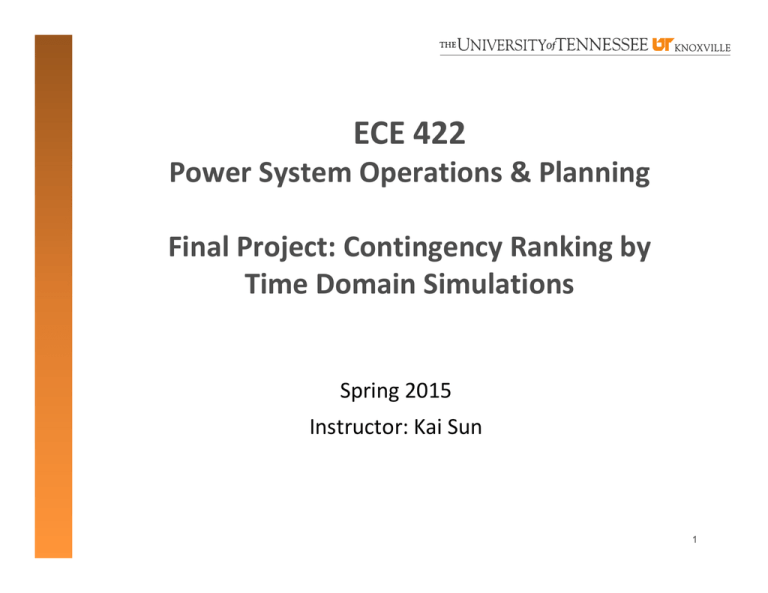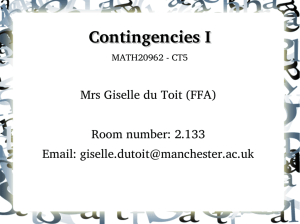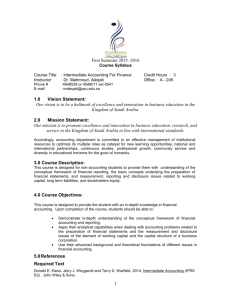ECE 422 Power System Operations & Planning Final Project: Contingency Ranking by Time Domain Simulations
advertisement

ECE 422 Power System Operations & Planning Final Project: Contingency Ranking by Time Domain Simulations Spring 2015 Instructor: Kai Sun 1 WECC 179‐bus System 2 Load Modeling • Load Model #1 (default): – P load is represented as 100% Constant Current load; Q load is represented as 100% Constant Z; convert P load to 100% Constant Z when the bus voltage is lower than 0.7pu • Load Model #2 (Constant Z): – All loads P and Q represented as Constant Impedance • Load Model #3 (Constant I): – All loads P and Q represented at Constant Current • Load Model #4 (Constant P/Q): – All loads P and Q represented at Constant Power 3 Requirements •3‐4 students in each team – You may decide who you want to work with and send me the names of your team members by 4/10 – After 4/10, I will assign the other students to groups •Data and a more specific work scope will be given on 4/13 •Classes during 4/16‐4/23 are cancelled (the final exam is on 4/21) •Each team gives a 8‐10 minutes presentation on 4/28 •A no more than 6 pages report due by 4/30. Use the IEEE paper template at http://www.ieee.org/conferences_events/conferences/publishing /templates.html 7 Software – TSAT in Powertech DSA Tools •Powertech DSA Tools are installed at server rd0.eecs.utk.edu •Please send ithelp@eecs.utk.edu a request for remote access of that server. •If you need any help on learning TSAT, please contact GTA Denis 8 Create a Project in Powertech’s TSAT 1. 2. 3. 1 Create a new project Select the powerflow file in PSS/E RAWD Rev. 30 (*.raw) or PSAT (*.pfb) format Specify the dynamic data file in DSATools format (*.dat) 2 9 Monitor Data 1. Create a monitor data file – The reference generator may be the swing bus 2. Add generators, buses or branches for monitoring 1 2 10 Contingency Data 3 Automatically create a list of N‐1 contingencies (all 3 phase faults on 500KV lines) 1 2 4 5 11 Load Modeling 12 Load Modeling 13 Automatic CCT Calculation 14 Automatic Stability Margin Calculation 15 Conduct Basecase Analysis 16 Groups 1, 3 and 5 Groups 1, 3 and 5 Groups 2, 4 and 6 Groups 2, 4 and 6 17 Group 1 Ryne Joseph Huff Blake Layfield, Randall Lumpkins, Stefan Leitner 2 Robert Germick, Ed Palmer, James Haney, Rob Stow 3 Alex Asbury, Derek Lusby, Nathan Peck, Jacob Woods 4 Tyler McGraw, Brad Bowles, Alex Joss, Jacob Favory 5 Ben Mills, Michael Honey, Ryne Clinard 6 Somasundaram Surendhar, Christ Bruffey, Faith Frye Project (WECC 179‐bus system) Data: System load: 61.4GW Task 1: N‐1 contingencies ranking for all 500kV lines Tasks 2.1: CCTs of Top‐5 contingencies in Zone 1‐A Tasks 2.2: CCTs of Top‐5 contingencies in Zone 1‐B Task 3: Load model comparison on the Top‐5 (ranked by CCTs) of those 10 contingencies in Zones 1‐A and 1‐B Data: System load: 61.4GW Task 1: N‐1 contingencies ranking for all 500kV lines Tasks 2.1: CCTs of Top‐5 contingencies in Zone 2‐A Tasks 2.2: CCTs of Top‐5 contingencies in Zone 2‐B Task 3: Load model comparison on the Top‐5 (ranked by CCTs) of those 10 contingencies in Zones 2‐A and 2‐B Data: System load: 52.1GW Task 1: N‐1 contingencies ranking for all 500kV lines Tasks 2.1: CCTs of Top‐5 contingencies in Zone 1‐A Tasks 2.2: CCTs of Top‐5 contingencies in Zone 1‐B Task 3: Load model comparison on the Top‐5 (ranked by CCTs) of those 10 contingencies in Zones 1‐A and 1‐B Data: System load: 52.1GW Task 1: N‐1 contingencies ranking for all 500kV lines Tasks 2.1: CCTs of Top‐5 contingencies in Zone 2‐A Tasks 2.2: CCTs of Top‐5 contingencies in Zone 2‐B Task 3: Load model comparison on the Top‐5 (ranked by CCTs) of those 10 contingencies in Zones 2‐A and 2‐B Data: System load: 46.9GW Task 1: N‐1 contingencies ranking for all 500kV lines Tasks 2: CCTs of Top‐5 contingencies in Zones 1‐A and 1‐B Task 3: Load model comparison on the Top‐5 contingencies in Zones 1‐A and 1‐B Data: System load: 46.9GW Task 1: N‐1 contingencies ranking for all 500kV lines Tasks 2: CCTs of Top‐5 contingencies in Zones 2‐A and 2‐B Task 3: Load model comparison on those Top‐5 contingencies in Zones 2‐A and 2‐B 18





